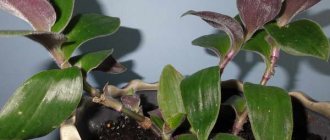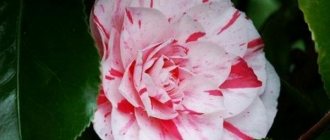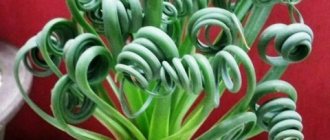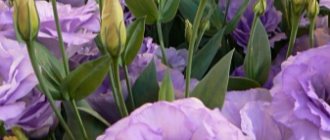Many people are familiar with a beautifully flowering indoor plant that resembles a rose. But unlike a rose, it has no thorns, and the leaves are shiny and glossy. We'll talk about camellia. The plant, which grows in countries with tropical climates, has taken its rightful place on the windowsills of our apartments and is very popular. In this article you will find useful information about growing and caring for camellias at home.
Description
The camellia is native to the countries of Central and Southeast Asia:
- Japan;
- China;
- Philippine Islands;
- countries of Indochina.
Under natural conditions, camellia grows as a shrub or tree, depending on the species. The most common type, Camellia sinensis, is called the tea bush. Its leaves are dried and used to make tea, hence the name “tea bush”. The decorative nature of camellia makes it an adornment of parks and gardens. Thanks to the work of breeders, new hybrid varieties have been developed.
The most famous types of camellia that are grown indoors are the following:
- Japanese;
- Chinese;
- mountain.
Japanese camellia
Japanese camellia grows up to 12 meters in places where it grows naturally. Flowers of double or semi-double structure have different shades from white to red. There are specimens with variegated flowers, solitary or collected in inflorescences. The leaves have a dark green tint.
Chinese camellia grows up to 15 meters and is distinguished by oval leaves with white edges. White flowers have a delicate aroma.
Mountain camellia grows as a bush up to three meters. On thin branches with oval leaves framed by teeth, large flowers grow up to 7 cm in diameter and emit a delicate aroma.
Chinese camellia
Mountain camellia
For indoor growing, camellia montana and japonica are more often used. The basis for selection is the species of Japanese camellia, which has good survival rate. Camellia blooms in winter, from November-December to April.
Types of camels with photos
Mountain camellia (Camellia sasanqua)
Or Camellia tegmentosa or Camellia miyagii - in nature this species is found on the islands of Kyushu and Okinawa. These shrubs are quite tall, so they can reach a height of 3–5 meters. The surface of the stems has pubescence in the form of reddish hairs, and the branches of this plant are very thin. The leaves are elliptical or elongated-ovoid in shape and are up to 7 centimeters long and up to 3 centimeters wide. Their edges are jagged, the glossy front side is painted dark green, and on the reverse side the midrib is pubescent. Simple fragrant flowers can reach 7 centimeters in diameter. They can be either single or grow in 2 or 3 pieces. The flowers are colored pink, red or white. Abundant flowering is observed in November–January. These plants prefer cool weather.
Camellia sinensis
Or Camellia bohea - found naturally in the forests of China and prefer to grow on mountain slopes or in gorges. This species is represented by both shrubs and trees, reaching a height of 15 meters. The leaves have an elliptical or ovoid shape and grow up to 10 centimeters in length and up to 4 centimeters in width. The glossy leaves are dark green. Young leaves are pubescent with whitish hairs, while older leaves are bare. The axillary flowers are white and have fairly short pedicels. They grow singly or in groups of 2-3.
Japanese camellia (Camellia japonica)
In nature, this species is found in the forests of China, Japan and Korea. Such shrubs or trees can reach 15 meters in height. The glossy, leathery, dark green leaves have denticles along the edge and are pointed at the top. Their shape is elliptical or ovoid, and the leaves grow up to 10 centimeters in length. Simple flowers reach 4 centimeters in diameter and can grow either singly or in several pieces. The flowers are semi-double and double, and they are colored pink, red or white, and they are also variegated. Blooms from December to April.
How to grow camellia at home. Garden World website"
Subtleties of care
Camellia is one of the plants that requires certain conditions to be successfully grown. Therefore, let's talk about how to grow camellia in city apartments and make it bloom. When you see a flowering plant on sale, you feel the desire to purchase a luxurious flower. But often such a purchase ends in the death of the plant after flowering ends.
Creating a comfortable temperature regime
The most important thing is to ensure temperature conditions, because for normal development a flower needs conditions close to natural. For flowering in winter, camellia is recommended to be kept at a temperature of 10-15 degrees. It can withstand slight sub-zero temperatures. It is impossible to maintain coolness in an apartment with central heating. But if you have a glazed, insulated loggia, balcony or cool veranda in a private house, then you can admire the flowering plant all winter. In summer, camellia prefers moderate temperatures in the range of 20-25 degrees.
Camellia is demanding on lighting, so with short daylight hours it is necessary to provide it with additional lighting. As a result, daylight hours should reach twelve to fourteen hours. When placing a flower on a window facing south, you need to take care to protect it from direct sunlight and moisturize it. The most suitable would be an eastern or western window, where the camellia is not threatened by the hot midday sun. On a window facing north, the plant shreds and stretches out.
This may be interesting: Crossandra - care and reproduction at home
Watering, moistening and fertilizing
Camellia is one of the flowers that begins to grow shoots in the spring. At the beginning of autumn, buds are laid and flowering occurs in winter. Therefore, watering and the application of mineral fertilizers must be organized taking into account the annual growth cycle. Camellia needs bottom watering through a tray, draining the remaining water after an hour and a half.
In the spring, when new shoots begin to grow, and in the summer, camellias need to be watered frequently and abundantly. But the soil should not be allowed to become waterlogged, because this will lead to rotting of the roots. In winter, watering is reduced to once a week. Camellias are harmed by an increase in calcium salts in the soil, so the water must be settled. You can use melted or boiled water. Sometimes it is recommended to add a small amount of vinegar or citric acid to the water to increase the acidity of the soil.
Camellia needs air humidification, especially if the pot with the plant remains in the apartment for the winter. Hot radiators dry out the air greatly, which can lead to buds and leaves falling off. Therefore, the foliage is periodically sprayed without moistening the soil. You can place the pot in a tray with damp expanded clay or moss. If possible, we recommend installing a humidifier, which will create a comfortable microclimate not only for the flower, but also for people.
In the spring, when young shoots begin to grow, you can start feeding camellias. To do this, use fertilizers for azaleas. The amount indicated on the package is halved. Fertilize no more than 1-2 times a month. In July, fertilization is stopped until next spring. When choosing fertilizers, you should pay attention to ensure that they do not contain calcium and magnesium. Excess calcium in the soil causes buds to fall off.
Crown formation
In order to give a compact shape and remove weak shoots, camellias are pruned. This procedure is performed at the end of flowering. After pruning, the plant produces new shoots more actively. Flower growers who have been growing camellia for many years already know how many shoots need to be left so as not to weaken the bush with abundant flowering.
By cutting shoots, you can form a bush or tree. After pruning, the cut of large woody branches is treated with garden varnish. It is permissible to trim shoots to half their length.
Important! During the formation of buds, we do not recommend rearranging or turning the pot, otherwise the plant may drop the buds.
Chinese
A lush, branched shrub, densely strewn with emerald-colored leaves (they are lighter on the inside and covered with hairs). Belongs to the Tea family. The flowers are pale pink or milky white. The fruits ripen in round boxes with three doors; they appear in the last month of autumn. The length of the trunk in an apartment rarely exceeds one and a half meters, but in natural conditions it can reach over 9 meters. Not a capricious plant, it looks good even on rocky soils. It tolerates snowy winters and early frosts well, but it is demanding when it comes to humidity: high humidity levels are needed. Doesn't like drafts. A delicious tea is obtained from the leaves of this species. In the photo below is the Camellia Sinensis variety:
Chinese camellia (Camellia sinensis)
Transfer
Camellias are replanted not in February-March, like other indoor flowers, but in late autumn or winter. She begins a period of rest, coinciding with flowering. Therefore, you can replant a flowering plant, being careful. Young plants need to be replanted every year. Large bushes can be replanted by transshipment once every two to three years, when the roots fill the entire volume of the pot.
In preparation for transplanting (planting), it is necessary to prepare a wide pot, at the bottom of which a layer of drainage is poured. You can buy land ready for azaleas and camellias. Since different manufacturers allow deviations in the composition, when purchasing a ready-made earthen mixture, you should pay attention to the presence of the following components in the soil:
- peat;
- sand;
- leaf soil;
- vermiculite.
You can prepare the mixture yourself by mixing peat, sand, leaf and coniferous soil. All ingredients are taken in equal parts, and sand - half as much. The soil must be loose to prevent stagnation of water. Soil acidity should be between 4.0–5.5 units. To increase its permeability, it is recommended to add ground coniferous tree bark. Its pieces are usually sold for planting orchids.
This may be interesting: Tabernemontana - home care
When replanting a flower, you should pay special attention to the root collar, which should not be covered with soil, but be at ground level. When transferring an adult plant to a larger pot, add fresh mixture. If it is necessary to increase the acidity of the soil, mulch it on top with sawdust or small pieces of bark.
How to care for indoor camellia video
- Camellia grown at home needs very frequent regular watering in warm weather and rare in winter.
- During budding and flowering, watering is reduced, otherwise the plant may lose color. When camellia blooms, it is better to water it through a tray with pebbles to avoid waterlogging.
- You need to make sure that the soil is not flooded with water, especially in winter - this is fatal for camellias.
- Moisten the substrate while the upper part of the soil is drying, but do not wait until it dries completely, so as not to cause wilting.
- Camellias are fertilized all the time, even in winter. Complete complex mineral fertilizer for flowering plants is applied monthly during watering.
From June to September, camellias can be kept on the balcony or in a shady place in the garden. Water moderately, not forgetting about fertilizing.
From October to February, camellia is kept in a cool room, maybe a corridor without heating, but so that there is a positive temperature of 7-13°C.
Camellia blooms from March to May. If you want to see large flowers, cut off half of the buds. This way the plant will show itself in all its glory.
Trimming
The second half of autumn is the time to prune excess camellia shoots. This is important so that the plant actively grows axillary buds and produces greenery. Branches can be cut at your discretion, shortening them by one third and cutting out branches that give an unsightly appearance. The crown is formed to your taste. And cut apical shoots can be used for cuttings and producing new plants.
Transfer
Camellia transplantation is carried out annually while the plant is young. Older specimens that bloom regularly need to be replanted every two years in the spring. During this procedure, be sure to pinch the tops of the shoots. Plant camellia in the same soil.
Transferring camellias into a larger pot video:
Reproduction
Camellia propagation is carried out in several ways:
- seeds;
- cuttings;
- layering;
- vaccination.
Growing from seeds
Camellia seeds
Seeds appear on a faded bush in the fall. If you want to start growing from seeds, they must be planted soon after collection, before they lose their viability. Unfortunately, in apartment conditions, camellia practically does not produce seeds. They are obtained either in natural conditions or in greenhouses. Therefore, you can buy seeds in flower shops, but there is no guarantee that they will sprout. Additionally, if the plant is grown from the seeds of a hybrid plant, it may not inherit all the traits and the flowers will look different from the parent. And the representative of the species, Camellia sinensis, transmits its characteristics when propagated by seeds.
Let's look at the steps for planting seeds:
- Ripe seeds should be dark brown, almost black. The main thing is that the purchased seeds do not dry out, so before planting they can be put in a bag and placed in the refrigerator. Before planting, the seeds are dipped in water. If they surface, it is not recommended to sow them.
- Before planting, it is enough to soak fresh seeds in water overnight. We recommend scarifying dry seeds to speed up germination. This can be done in two ways. The first is to cut or pierce the shell of each seed, being careful not to damage the core. The second method is to alternately immerse it several times for a few seconds, first in boiling water, then in cold water.
- A planting mixture is prepared from equal parts of peat and sand. You can take soil for azaleas and camellias. The seeds are placed in the soil, slightly pressing. Place each seed with the “eye” from which the root will appear, down or to the side. You can sprinkle a thin layer of sand or vermiculite on top.
- Propagation by seeds requires careful adherence to temperature conditions. The pot is placed in a place with a temperature of 23 degrees. It is also covered with glass and cellophane to maintain humidity. It is also necessary to provide slight shading from sunlight.
- It will take several months for the seeds to germinate. After the second leaves appear on the sprouts, they are planted in separate pots, picking. Camellia grown from seeds is characterized by good adaptability to new conditions. Flowering of a young plant occurs after approximately five to eight years.
Planting seeds
Growing from cuttings
It is easier to grow a flowering plant using cuttings, which are taken in late May - early summer. At this time, the shoots turn brown and are ready for cuttings.
You cannot take green shoots, as they will not take root. It is worth paying attention to ensure that the growth bud is well developed. The soil is taken the same as for camellia seeds - a mixture of peat and sand in equal proportions.
Rooted cuttings
Before planting, it is recommended that the end of the shoot, which goes deep into the ground, be dipped wet in a rooting powder, for example, Kornevin. There are other rooting agents on the market, so don’t stop at Kornevin only. The soil should be moist, and it is recommended to cover the planted cuttings with film or a jar to maintain the humidity level. Four months are enough for cuttings to root. During the rooting period, it is necessary to maintain a constant temperature of 23 degrees. At higher temperatures, leaf growth may begin, and the root system will be delayed in development, and the sprout may die. Flowering occurs after two years.
This may be interesting: Popular types and varieties of indoor Koleria (Kaleria)
Reproduction by offspring
Root shoots that appear in an adult plant and have reached a sufficient size, when transplanted, are separated from the parent bush and planted in a separate pot. This is one of the simplest methods of reproduction, but you have to wait a long time for the offspring to appear and develop.
Reproduction by grafting
Camellia grafting is performed using two methods:
- butt;
- splitting
The butt drive makes it possible to achieve propagation for camellia species that do not root well from cuttings. The root system of the scion is preserved until its complete survival.
Reproduction by grafting
Camellia is also grafted using a new method specially developed for it. A cutting is taken for rooting and a shoot grown from seeds. The shoot must be at least five centimeters. Its root is split and cut off at the level of the cotyledons. The cut is split and the tip of the cutting is inserted into it. Rooting of cuttings is carried out in pots in soil consisting of peat and sand (1:1 ratio). The pot is covered with cellophane and a jar.
Caring for camellia flowers in open ground
Nowadays, breeders have developed many varieties of garden camellia that grow well in open ground even in regions with harsh climates. But in order to achieve success in growing and see flowers on a garden plant, you need to put in a lot of effort and patience.
Preparing the soil and planting camellias
Growing camellias in the garden should begin with preparing the soil. Since garden soil is dense and does not allow water and air to pass through well, it needs to be slightly improved. To do this, make good drainage, acidify the soil and add peat, sand and compost. It is better to plant a flowering camellia in a permanent place, since at this time it is in a dormant period and, with the accumulation of strength, will tolerate transplantation much better.
How to properly transplant camellia into open ground:
- The purchased plant is carefully removed from the container, trying to preserve the earthen lump.
- When installing a plant in a hole, you need to make sure that the root collar is not too deep into the ground. But you shouldn’t leave it close to the surface of the earth, as there is a possibility that the plant will not survive the winter.
- After transplantation, the soil is compacted, watered and mulched.
- If several plants are planted, the distance between the holes should be at least 2 m.
Camellia is planted in a pre-diluted hole
Watering and fertilizing
Garden camellia is very demanding on water quality. You cannot water the shrub with tap water, as it contains a high lime content. In hot summers, the plant is watered 2-3 times a month. The first sign of a lack of moisture is the leaves drying out and falling off. In rainy summers, no watering is required.
Tree camellia is an ideal solution for landscape decoration
In the spring, during the period of active growth of young shoots, garden camellia needs to be fed twice a month. Feeding must be of high quality. Fertilizers intended for feeding azaleas are suitable for camellias.
In the autumn, feeding is stopped, and the bushes begin to be prepared for wintering.
In regions with harsh climates, the plant is dug up and stored indoors
How to prune camellia to form a crown
They begin to form the crown in the spring by pinching the shoots. This is necessary for better branching of the bush. In autumn, shoots are pruned to stimulate the growth of axillary buds.
Pruning is carried out with a sterile sharp instrument
Preparing for winter
If camellia grows in a region with harsh winters, it must be dug up and wintered in a room where the air temperature will not drop below +2°C. In regions with a mild climate, the plant is covered with breathable material.
Diseases and pests
Most problems with camellia are associated with violations in the maintenance and watering of the plant. We list the possible causes and their consequences:
- Dropping of camellia buds and browning of leaves is often associated with overwatering. In this case, soil acidification may have occurred. It is necessary to establish proper watering, or, as a last resort, replace the soil, paying attention to good drainage.
- Brown spots that appear on the leaves in summer indicate sunburn. It is recommended to shade the flower.
- Irregular watering, which leads to dry or waterlogged soil, causes leaves to fall off. There is only one way out - to establish proper watering.
Diseases and treatment
Gray spots on the leaves mean that the camellia is affected by oidium. At the onset of the disease, you can apply treatment (washing, wiping) of the leaves with a soap solution. In case of severe damage, it is recommended to use fungicidal preparations for treatment according to the instructions.
Camellia affected by oidium
Camellia japonica is prone to cucumber mosaic disease, which manifests itself as yellowing of the leaf veins. Insecticides are used for control.
Due to fungal infection, the leaves become covered with black spots and the flower petals become brown. Progression of the disease can lead to shedding of flowers. Treatment with fungicides will help in the initial stages of the disease. If the treatment is not successful, then such a flower should be thrown away.
Pests
The main pests of the beautiful camellia are aphids, mealybugs, scale insects, spider mites, and lone mower.
White mealyworm larvae are easy to spot on leaves. They are removed with a cloth moistened with soapy water or alcohol or cologne. Damaged leaves can be trimmed. As a last resort, the plant is treated with karbofos at the rate of twenty to forty drops per liter of water.
Mealybug
Controlling aphids, which cause leaves to turn yellow and wrinkle, requires patience and persistence. Adults can be removed with a soap solution or special aerosols. It is recommended to carry out treatment every two to three days to destroy new insects.
To combat spider mites, the best and safest for others are oil emulsions that are sprayed on the plant.
Spider mite
When the scale insect appears, the leaves turn black and brown tubercles appear on them. They are removed manually and then treated with insecticides. Be sure to move the flower away from other plants.
Shchitovka
The mower damages the root collar of the flower, which leads to the death of the plant if the pest is not recognized in time and the bush is not treated with insecticides.
Possible problems with growing camellias
Camellia is an overly delicate plant, which suggests that the flower is vulnerable to all kinds of parasites, pests, and diseases. Camellia is affected by spider mites, aphids, scale insects, and thrips. The plant is treated with universal or more specific insecticides to defeat pests. Diseases practically do not affect camellia.
Maintaining a strict watering regime is an extremely important condition for caring for a tea plant. The requirements for cultivation mentioned that overmoistening and overdrying are equally destructive. The first problem leads to brown coloration of leaves and shoots and debudding, and the second leads to complete loss of foliage.
Camellia home photo Growing and care Camellia diseases and pests
When exposed to the scorching rays of the sun, camellia may become covered with brown burn spots - you need to react immediately and shade the plant.
High air temperature, lack of optimal humidity, poor lighting, alkaline or neutral soil are the worst enemies of camellia.
Types and varieties
Frost-resistant camellia varieties include:
- Donation. The flowers of this variety have a rich pink color and reach 10 cm in diameter. At first glance, the plant is quite fragile, but it is not so. This variety is not so demanding in care. A gardener who has never dealt with camellias can grow it on his own plot. A feature of this shrub is its very slow growth.
- Freedom Bell blooms with bright red flowers.
Dense glossy petals create a waxy effect. The variety is not afraid of pruning. Any deteriorated branches of the plant, and the bush grows quite densely, can be removed without fear. Camellia japonica, variety Donation - Debbie. The flowers are purple in color and are about 7-8 cm in diameter. The variety is similar to Donation and is suitable for growing by gardeners without experience. Suitable for cultivation in the Krasnodar region, the Urals and Siberia.
- Hagoromo is a variety whose flower colors change. He is also called the Empress. The buds of the plant have a light pink tint, and the blooming flowers are pearly white. The shrub develops slowly, growing in height rather than width. The diameter of the flowers is about 10 cm.
- General Colletti. The diameter of the double flowers of this variety ranges around 7 cm. The petals are white, with coral streaks. This variety is popular in the Moscow region.











